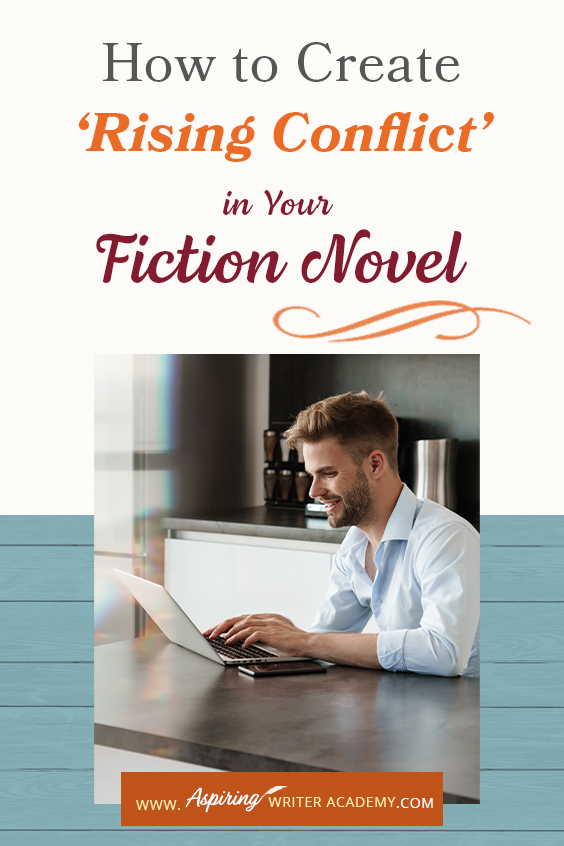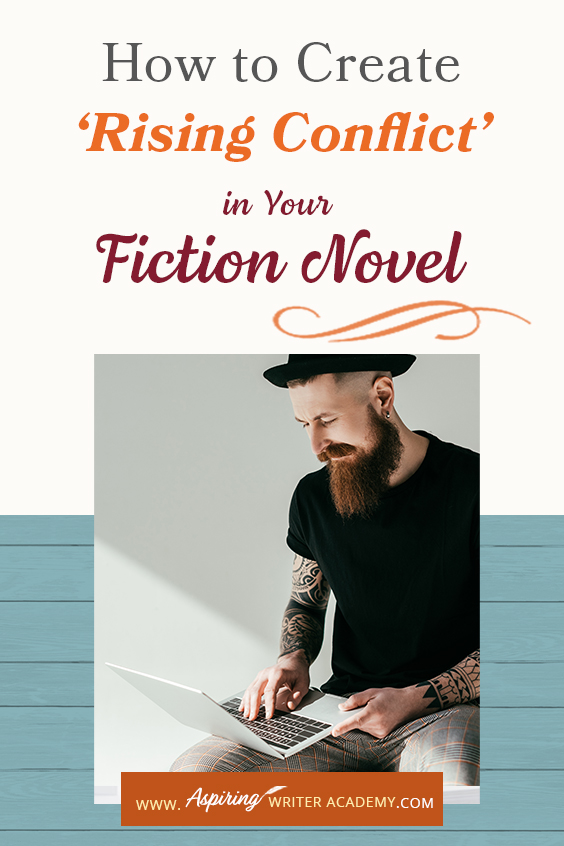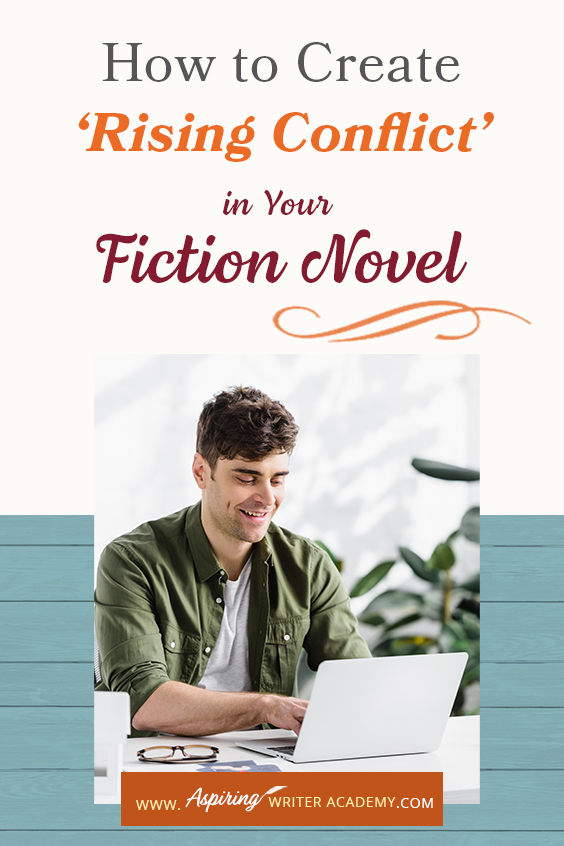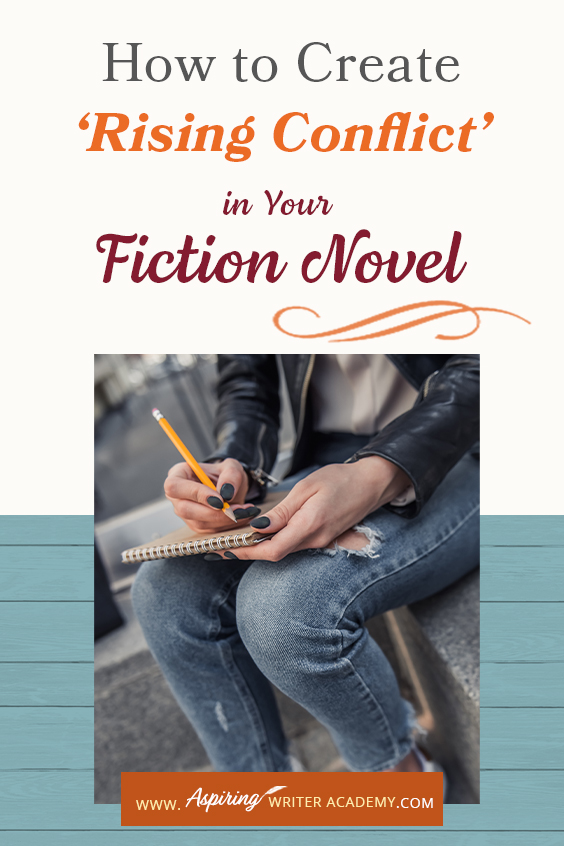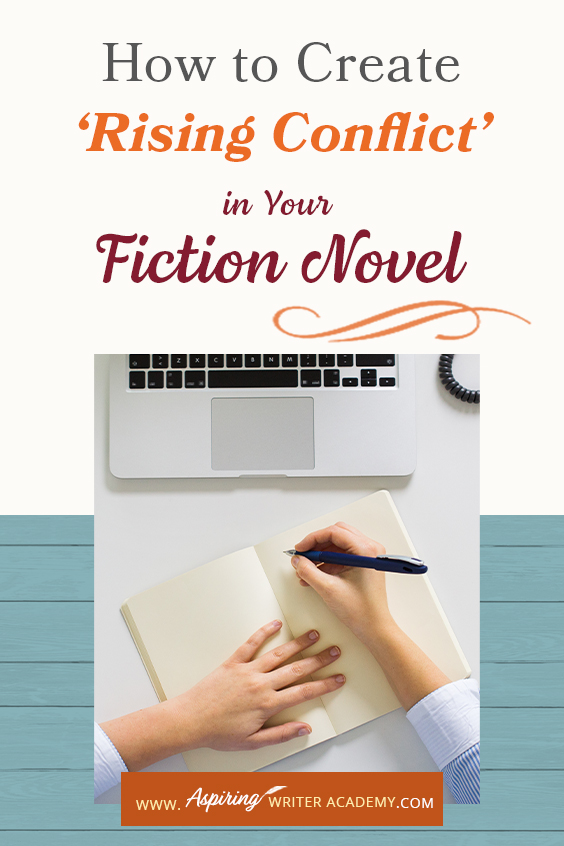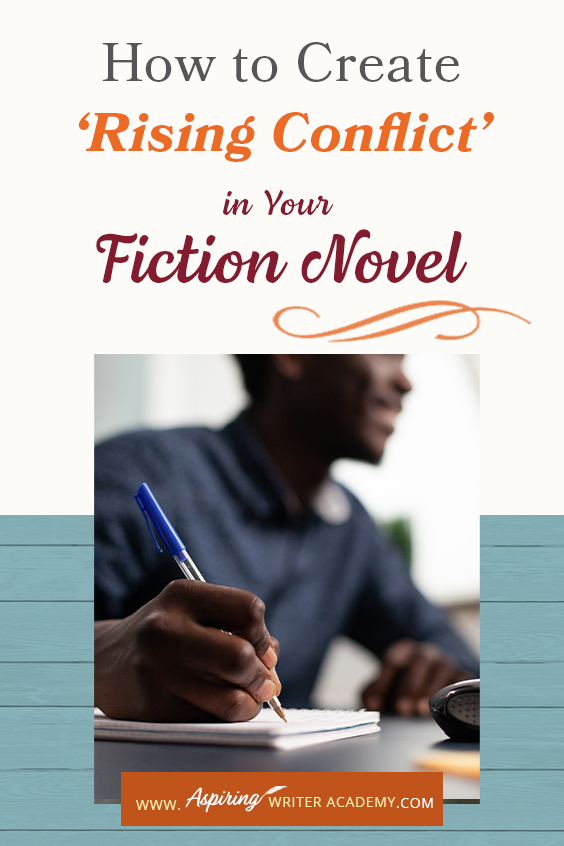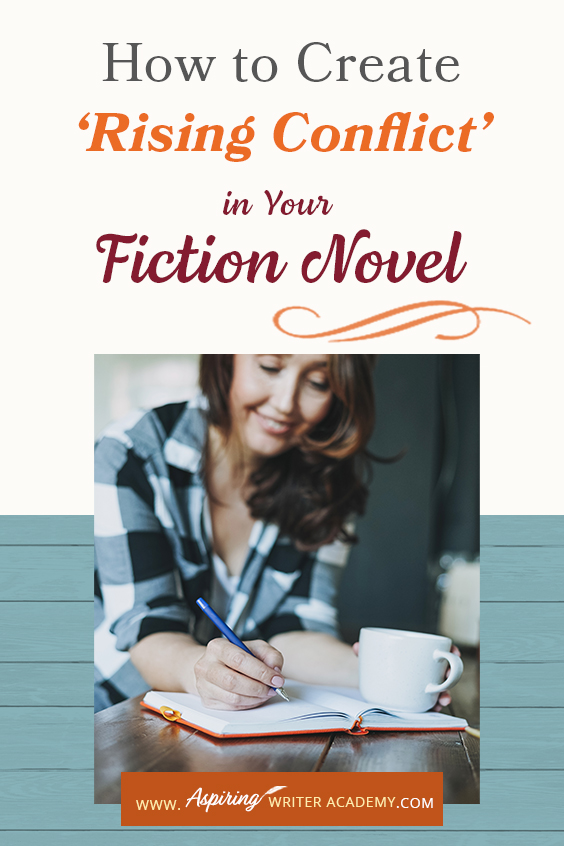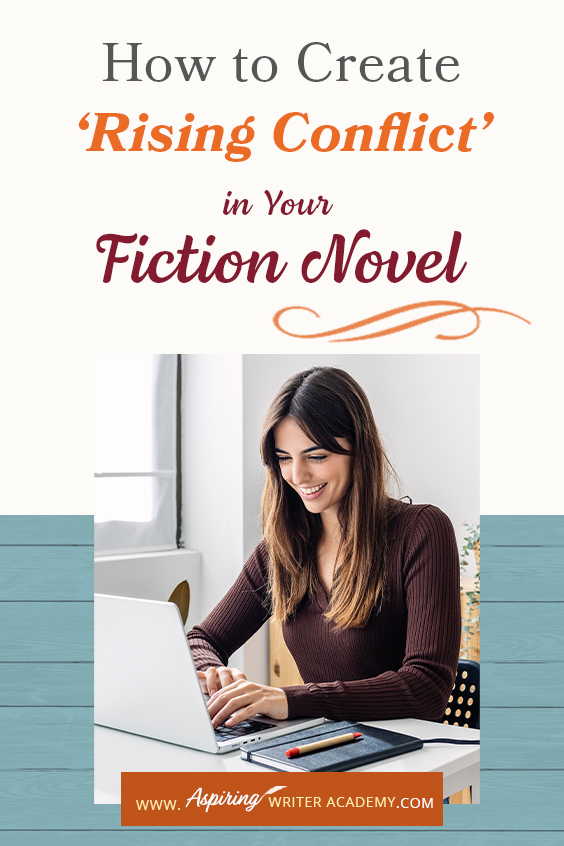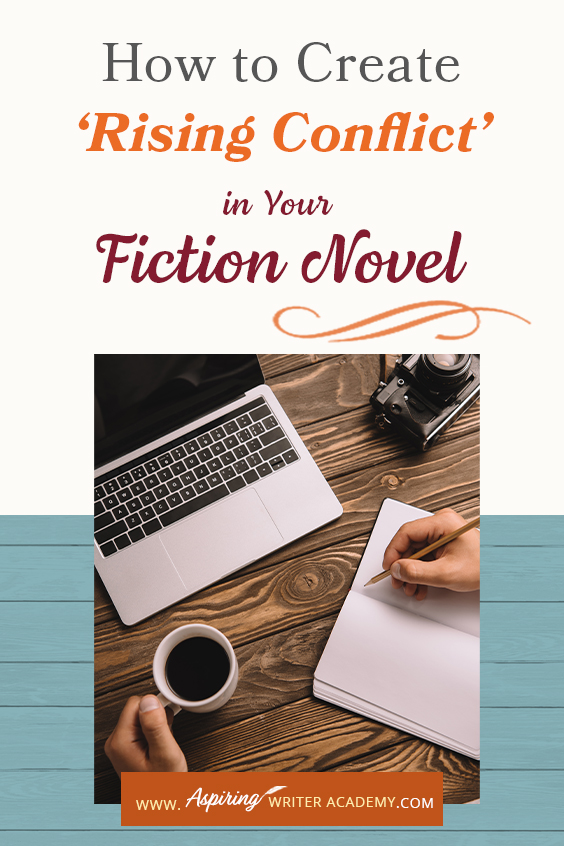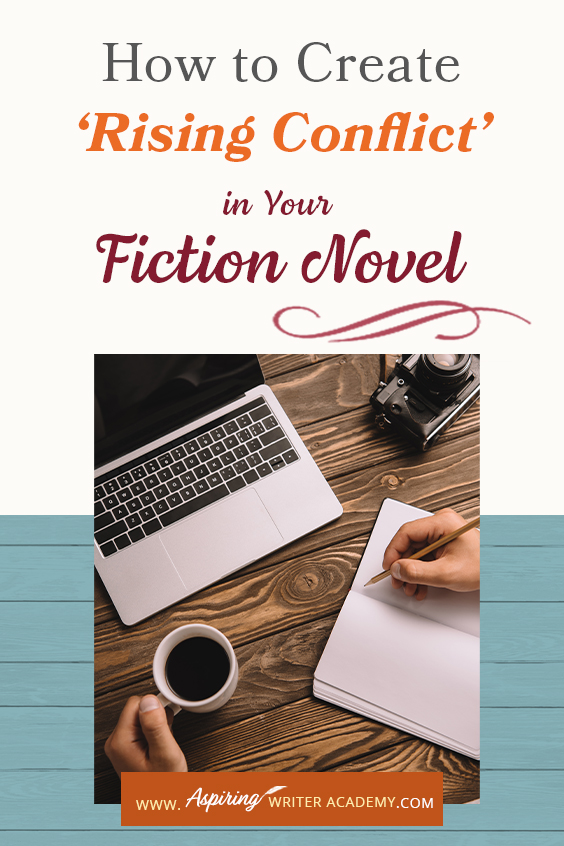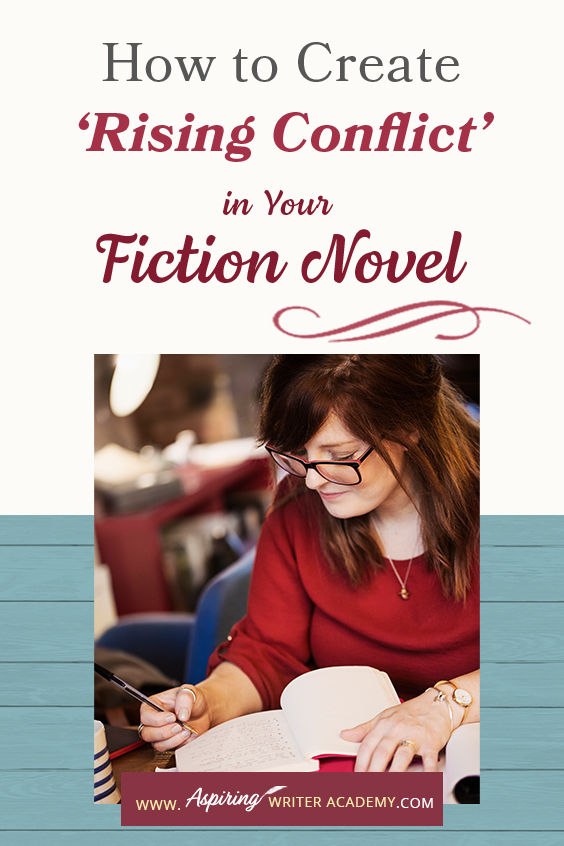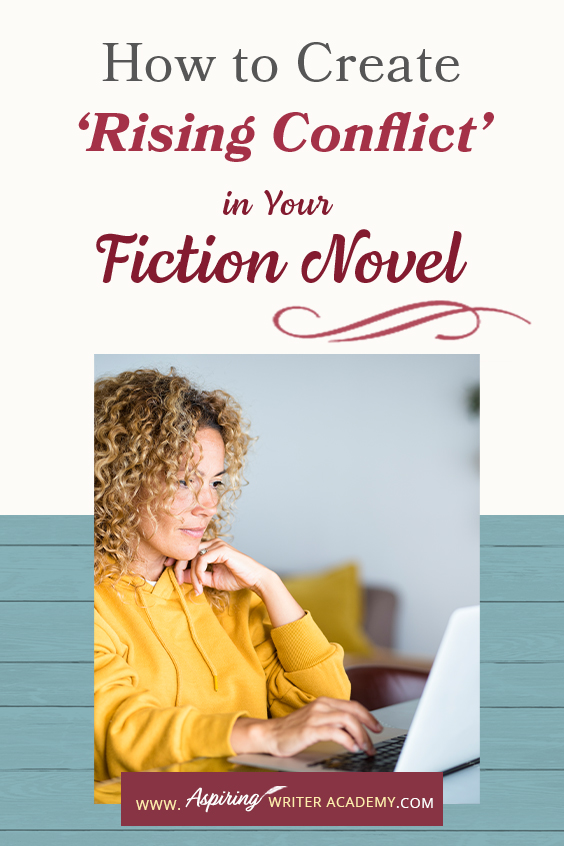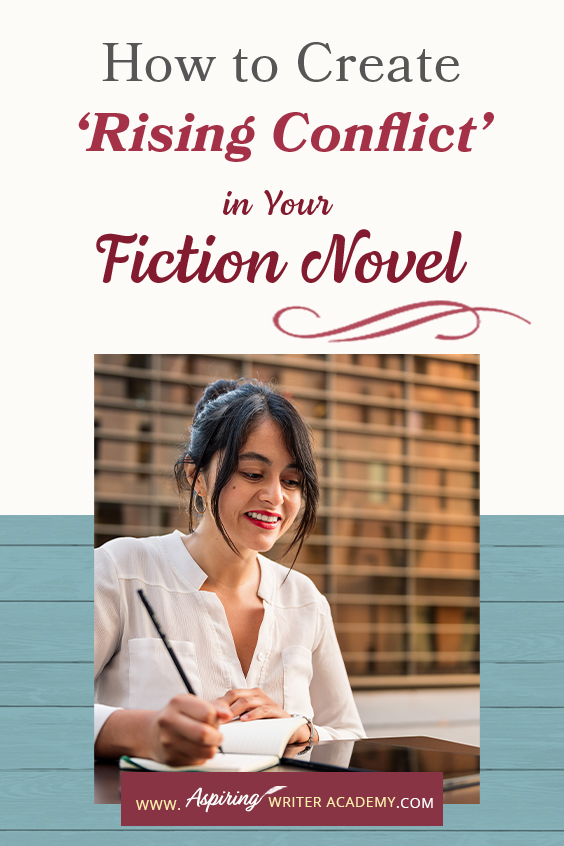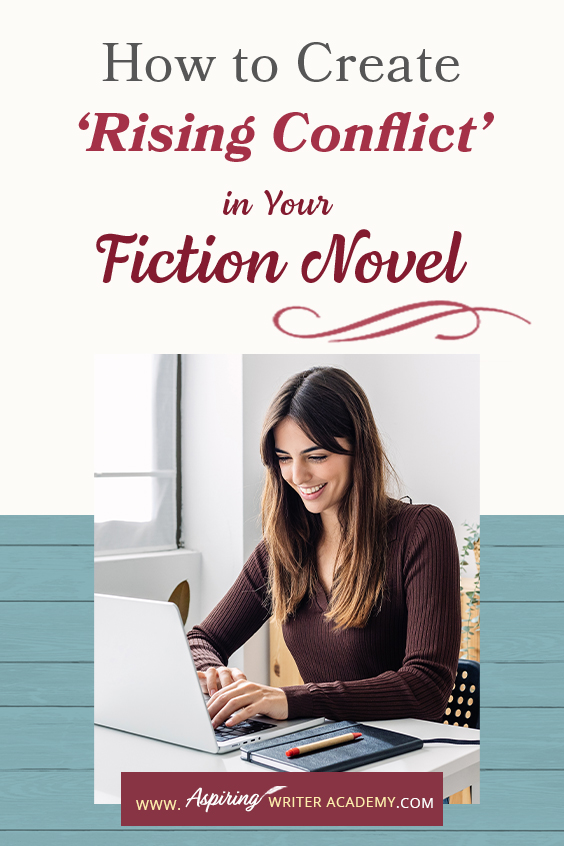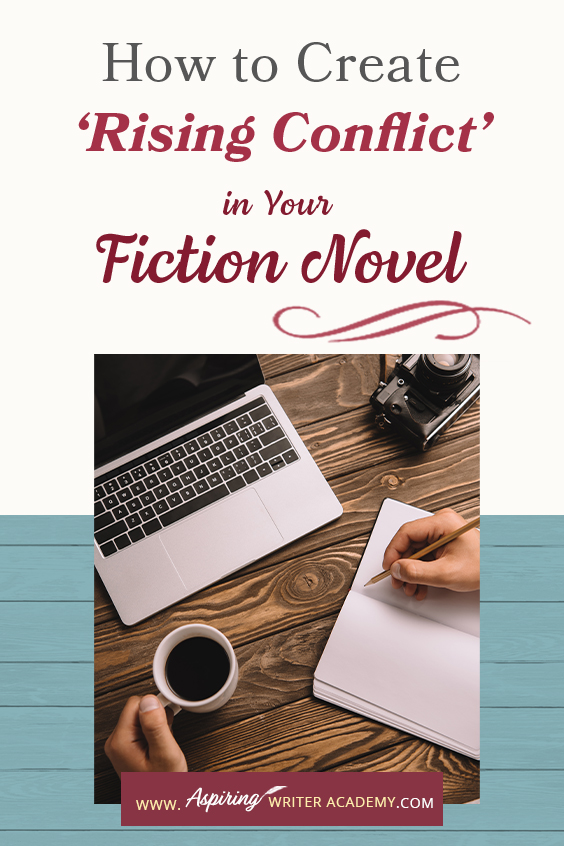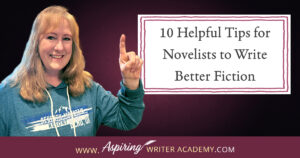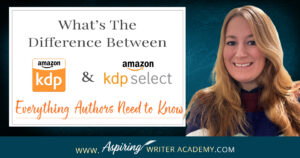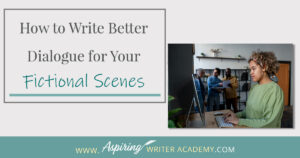How to Create ‘Rising Conflict’ in Your Fiction Novel
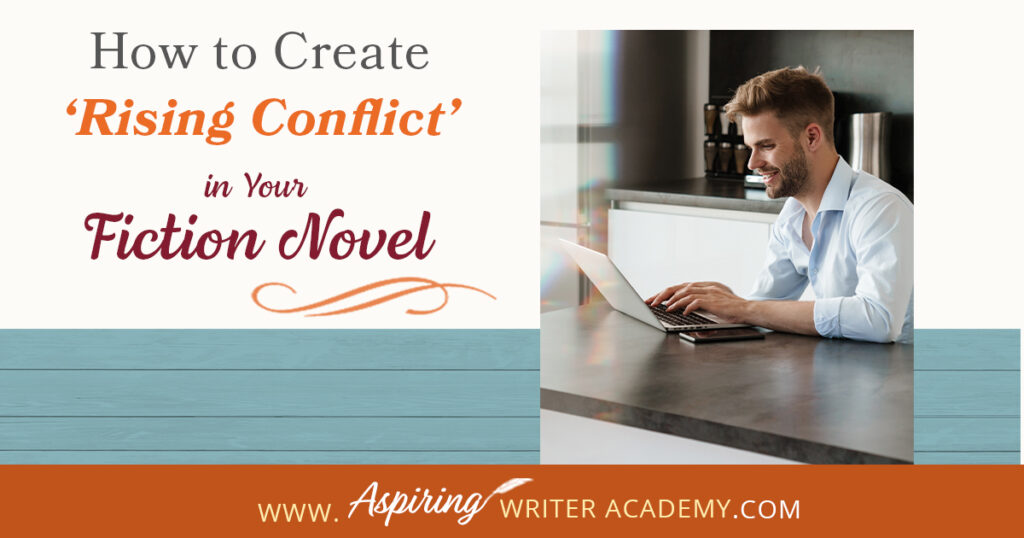
‘Rising Conflict’ in a fictional novel adds tension, moves the story forward, and helps create character change. But what exactly is rising conflict? Does every book need conflict? And what is the difference between internal and external conflict?
In How to Create ‘Rising Conflict’ in Your Fiction Novel, we address each of these questions and show you step-by-step how to create rising conflict at the scene and overall story level to write a riveting book your readers will love.
In the post below we will discuss:
- Why does a fictional novel need conflict?
- What is internal and external conflict?
- What is ‘rising conflict?’
- How do you create ‘rising conflict’ in a scene?
- How do you create ‘rising conflict’ in the plot?
Why does a fictional novel need conflict?
Simply put, without conflict, you might have a nice meandering tale but no true story.
At the heart of every good fictional novel is a conflict that needs to be resolved.
Conflict challenges the protagonist and helps develop his inner character. How a protagonist responds to obstacles exposes his values, personality, strengths, and flaws. Conflict reveals who your character is deep inside and what he might need to change. Ultimately, a story is about character change, and it is the conflict the character faces that changes him.
Conflict adds tension to the story, which engages the reader, and moves the story forward. Conflict can also bring purpose or a deeper meaning to the storyline to make it memorable.
What is Internal and External Conflict?
Your protagonist should struggle with both Internal and External Conflict.
Internal Conflict: when a character faces a challenge within himself.
Your character may face a situation that causes him great anxiety, such as having to decide whether to tell the truth or lie. Or having to choose between love and duty, or between ambition and his conscience. Tough situations where the character is forced to make tough choices create stress and inner turmoil. The consequences of his decisions can alter the trajectory of his life and possibly the lives of others. Your character may wrestle with indecision over a specific dilemma for one moment, one scene, or throughout the entire novel, but at some point, he will need to resolve this conflict in order to move forward. The struggle is inside the character’s mind.
External Conflict: when a character faces a challenge thrust upon him by the outside world.
Your character may be arrested for a crime he did not commit. Or an antagonist or villain may do something to turn your protagonist’s life upside down and he must find a way to fix it. Your main character may go on a challenging life-threatening quest to find lost treasure while fighting off others who want to claim it for their own. Or a rancher may want to save his land from greedy developers who are trying to drive him out. External conflict is created by the opposition. Who opposes your protagonist? What must your protagonist do about it? While this can also cause internal conflict, external conflict is the physical outward problem the character must resolve.
If the rancher is trying to save the ranch, he must take action to save the ranch. The question is how?
If the character must prove his innocence in a court case, then the external conflict is how can he prove his innocence?
If the character wants to find the lost treasure, the external problem is how does he overcome the life-threatening challenges to obtain it before all the others who want the treasure?
A good fictional novel should have plenty of conflict, both internal and external, at work in every scene. Yes, every scene! Your novel should have scene-specific minor conflicts that your character must overcome in order to resolve the overall major story conflict by the novel’s end.
What is ‘Rising Conflict?’
Rising conflict in a fictional novel refers to slowly escalating obstacles leading to the climax (the big face-to-face confrontational show-down between the protagonist and the opposition) at the end of the story. With each scene and chapter, the struggle the character faces must grow harder, the obstacles become larger, the consequences of failure become greater. Think of your character slowly climbing a staircase.
This is also referred to as ‘raising the stakes.’
Writer Beware #1: Unchanging Conflict
One common problem aspiring writers make is writing a scene or a series of scenes that only rehashes the same problem (or argument) over and over without any resolution, decision, action, or forward movement. The story becomes ‘stuck.’ Static. The characters may be engaged in an intense battle but there are not any new developments to escalate the conflict. Or a character may have an argument with someone and then go over to the coffee shop to tell her friend what just happened, then go home and tell her mother what happened, then repeat the story to someone else and ask their opinion. These scenes do not move the story forward. The reader becomes bored having to listen to this four times! The character never makes a decision or embarks on a new course of action. The plot isn’t going anywhere but becomes motionless, unchanged.
Solution:
Use the components of Scene & Sequel to help you get unstuck and move the story forward.
The Elements of Scene:
A character enters the scene with a scene goal.
The character is faced with opposition to that scene goal and engages in at least 3 exchanges of conflict within the scene in the form of action, dialogue, or body language.
Example: If a couple is arguing – the girl wants to go to the movie and her boyfriend doesn’t, they should have 3 back and forth (stimulus and response) units. She can stomp her foot and he can scowl, or she can say the movie has good ratings and he can argue he heard differently, or she can tug at his arm and he can pull away.
Finally, at the scene’s end this conflict must be resolved. If the girl is the protagonist, then either:
Yes, she wins, and her boyfriend agrees to go to the movie, but with strings attached. He must bring along another girl, who is in town visiting his family, and it is rumored that they used to date.
(Now the reader is already anticipating what will happen in the next scene because of this ‘hook’ which moves the story forward.)
Or second option: the boyfriend says, no, he will not go to the movie, and the girl is forced to go alone. (What will happen to her there?) Did she not want to go alone for a particular reason? Did she want to prove to her high school nemesis that she did indeed have a great guy who liked her? To go alone might show she’s unlovable. Perhaps she will decide not to go after all and stay home. Now she will have to think of another way to prove her nemesis wrong.
Or third option: The boyfriend says, no, he will not go, and furthermore…he breaks up with her. Now she is heartbroken and alone and what will she do with the set of tickets she has already purchased for the upcoming town dance? Will she sell them or ask someone else to go with her?
Elements of Sequel:
Emotion: What is the knee-jerk gut emotion or reaction your character feels in response to the disaster just delivered at the previous scene’s end?
Thought: What is the first few thoughts that come to mind? What does she think about her boyfriend now?
Quandary: What dilemma does she now face? What can she do now? What are her two choices? (Yes, limit it to just two!)
Decision: She makes a decision on her next course of action (choosing one of those two choices.)
This decision will become her next scene goal. She will enter the next scene with this action.
Writer Beware #2: Jumping Conflict
Another mistake new writers often make is to leapfrog the characters and the intensity of the story from one level to another without proper motivation or transitional sequences. The reader needs to be able to understand how a character who is quiet and reserved in one scene can raise her voice and criticize her boss in the next. What led to this transition? Did she find a piece of information between the two scenes that propelled her to change?
Are your character’s actions properly motivated? The reader will shake her head if you have a selfish character suddenly sacrifice his life for others by diving in front of a cannon. What caused this character to change in so short an amount of time? Did you show that change to the reader? Why would someone who is selfish do such a thing without proper motivation?
Solution:
Let the reader into the character’s head to hear what he or she is thinking and feeling. Use internal monologue and internal conflict to reveal what is at stake for this character.
Again, go through the components of Scene & Sequel to help deliver the emotions, the thought process and decision-making process of this character on to the page.
How do you create Rising Conflict in a Scene?
1) At the beginning of the scene, look at your protagonist’s emotional state. Is he happy? Calm? Unaware of a secret that is about to be revealed? Show how your character thinks and feels as he enters the scene with his scene goal. Is he hopeful he will achieve his goal?
2) Next have him encounter the opposition and the first exchange of conflict. Who or what is acting as the opposition? How does the character feel about being opposed? How does this change your character’s attitude or way of thinking just a little bit? Does it bring his hopes and dreams down a notch?
3) As your protagonist counters the opposition with arguments or actions of his own and confronts a second round of conflict either in dialogue or action or body language/subtext, how does this increase the stakes of achieving the scene goal? Is the character even more unsure of himself? Is his happiness incrementally fading?
4) In a third round of conflict within this scene how does this change the protagonist even further? Is he growing desperate to prove his point in an argument? Growing despondent, unnerved, or angry? Does the opposition startle him by revealing a secret that changes everything?
5) Finally, at the climax of the scene the protagonist must face the resolution. Did he achieve his scene goal but with strings attached? Consequences?
Or did he fail to achieve his goal?
Or did he fail to achieve his goal and because he tried, things are worse now than ever before?
How does your character feel about this? Has his emotions or viewpoint changed from the beginning of the scene? Was this shown incrementally on the page for the reader?
At the end of the scene, has the story progressed? Are things going to be harder now, more challenging for the protagonist going forward?
Note: You should not always have your characters going from happy to sad. If they end one scene feeling miserable, start the next scene with them feeling miserable and by scene’s end change them to getting some news that makes them feel good again. However, the change should be understood and well-motivated. Also be careful that your patterns do not become too predictable for the reader.
How do you create Rising Conflict in the Plot?
While each scene should contain rising conflict, the novel as a whole should also rise in intensity with the over-arching story conflict becoming more complicated, more desperate, more dangerous, more thrilling, more consequential with each and every step. With every scene and chapter there should be more at stake, more on the line to motivate the character to fight onward to achieve his overall story goal and overcome the opposition once and for all.
1. Start by showing the reader who your protagonist is at the beginning of the story. What are his habits, his skills, his weaknesses?
2. Next, the opposition presents the protagonist with a major story problem the protagonist must resolve if he is to ever have a normal life again. The opposition is a threat to the protagonist, raising the stakes.
3. The protagonist creates a plan to overcome this major life problem and takes the very first step toward achieving his goal. This takes him further out of his comfort zone.
4. It will take several steps to achieve this overall story goal, and the protagonist will encounter setbacks and attacks from the opposition at every turn. This forces the protagonist to be resourceful, learn new skills, perhaps get help or develop new relationships. Each hurdle the protagonist needs to overcome should be greater than the last.
5. The events of the story slowly change the protagonist, perhaps physically, mentally, emotionally, or spiritually, and give him new insight into his problem at hand. He slowly gains the capabilities to confront (and battle) the opposition at the Climax of the novel where it will be decided once and for all—will he overcome the opposition, resolve his story problem, and achieve his story goal or not?
6. After the Climax, do not wrap up your story too quickly. Make sure you resolve all the story threads, subplots, and have a capping off scene where you show the protagonist doing something that he could not do before. Prove to the reader that he has changed for the better.
If a man could not commit to marriage at the beginning of the novel, have him get down on one knee at the end and propose to the love of his life.
If he could not forgive before, show him forgiving someone at the end.
If he could not trust his team members in the beginning, show that they have resolved their differences and can trust one another now.
The challenges (rising conflict) the character faces throughout the story journey changes him incrementally and the amount of change is shown at the end. Let the reader see how far this character has come.
- How different is he now than he was at the beginning of the story?
- Can you chart the rising conflict in your story from beginning to end?
Rising conflicts provide the steppingstones for character change.
We hope you have enjoyed How to Create ‘Rising Conflict’ in Your Fiction Novel and that you have gained some valuable tips to escalate the tension and conflicts in your story.
If you have any questions or would like to leave a comment below, we would love to hear from you!
If you like more help developing your story, you may wish to download our Free Brainstorming Your Story Idea Worksheet
Do you find it difficult to create compelling antagonists and villains for your stories? Do your villains feel cartoonish and unbelievable? Do they lack motivation or a specific game plan? Discover the secrets to crafting villains that will stick with your readers long after they finish your story, with our How to Create Antagonists & Villains Workbook.
This 32-page instructional workbook is packed with valuable fill-in-the-blank templates and practical advice to help you create memorable and effective antagonists and villains. Whether you're a seasoned writer or just starting out, this workbook will take your writing to the next level.
We Believe All Authors Can Aspire to Take Their Writing to the Next Level!
Our Goal for Aspiring Writer Academy is to help people learn how to write quality fiction, teach them to publish and promote their work, and to give them the necessary tools to pursue a writing career.

ENTER YOUR EMAIL BELOW
TO GET YOUR FREE
"Brainstorming Your Story Idea Worksheet"
7 easy fill-in-the-blank pages,
+ 2 bonus pages filled with additional story examples.
A valuable tool to develop story plots again and again.
Other Blog Posts You May Like
How to Write Your Very First Fiction Novel
How to Plot: One Central Storyline
How to Use ‘The Hero’s Journey’ to Plot Your Novel
10 Tips for Using Flashbacks in Your Fictional Novel
How to Use Framing Techniques in Your Fictional Novel
How to Write a Novel with the W-Plot Template
How to Use Themes in Your Fictional Story
Fiction Writing: What is a Pinch Point?
7 Tips for Writing a Story Synopsis
Fiction Writing: What is the ‘Black Moment?’
Fiction Writing: What is the ‘Man in the Mirror Moment?’
Fiction Writing: What is a Plot Hole?
How to Write Act III and Finish Your Fictional Story in 5 Steps
Structuring Act II (Part 2) for Maximum Impact: How to Keep Readers Engaged
Structuring Act II (Part 1) for Maximum Impact: How to Keep Readers Engaged
How to Use Setting to Intensify Your Fictional Scenes
How to Manipulate Pacing to Increase the Intensity of Your Scenes in a Fictional Novel
How to Brainstorm a New Novel Using Goal, Motivation, and Conflict
Fiction Writing: How to Plot a Story where the Antagonist is an ‘Invisible Foe’
Fiction Writing: Create a Storyboard to Map Out Your Scenes
3 Ways to Avoid Writing ‘Episodic’ Scenes in Fiction
How to Write Act I: Opening Scenes for Your Fictional Story
Brainstorming Fiction: What to Do When Your Story Gets “Stuck”
How to Plot Your Fictional Novel (with Free Template Included)
5 Questions to Create Believable Villains

is a multi-published author, speaker, and writing coach. She writes sweet contemporary, inspirational, and historical romance and loves teaching aspiring writers how to write quality fiction. Read her inspiring story of how she published her first book and launched a successful writing career.

